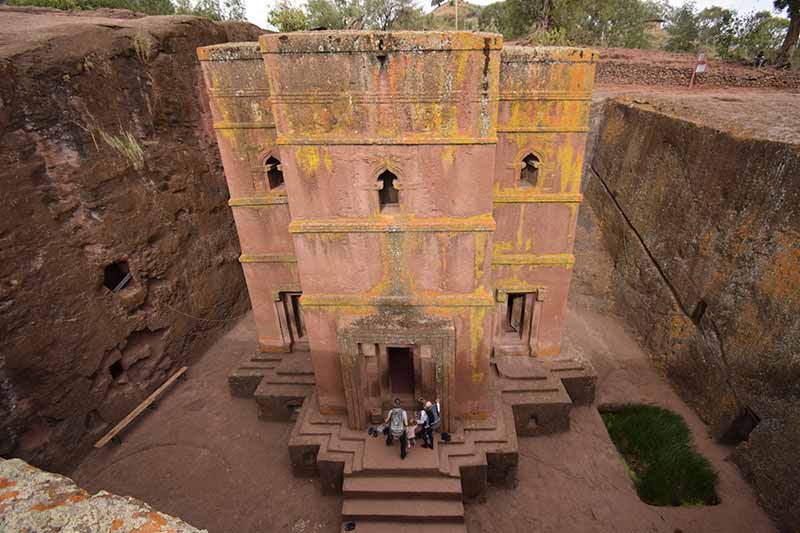Table of Contents
Introduction
Ethiopia has a rich and ancient civilization going back over 3,000 years. This long history has left behind many historical treasures and ancient wonders that provide a glimpse into the past. Ethiopia has the distinction of being one of the only African countries to avoid colonization, helping preserve its ancient roots. From rock-hewn churches to imperial castles, let’s explore some of the main historical sites and artifacts that make up Ethiopia’s ancient wonders.
Lalibela Rock-Hewn Churches
Lalibela, located in the northern highlands of Ethiopia, is renowned for its unique rock-hewn churches carved out of solid bedrock. Built in the 12th-13th century A.D. during the Zagwe dynasty, Lalibela is home to 11 monolithic churches each carved from a single rock and interconnected through a maze of tunnels. King Lalibela commissioned these extraordinary churches, with the largest church representing Ethiopia’s Jerusalem. This engineering marvel features windows, columns, and roofing carved in situ. Lalibela’s rock-hewn churches have made it a UNESCO World Heritage Site.
Aksum Obelisks
The ancient city of Aksum was the center of the powerful Kingdom of Aksum which dominated most of Ethiopia and parts of Africa from 100-940 A.D. This kingdom erected several giant obelisks carved from single blocks of granite. The largest standing obelisk reaches about 72 feet high and weighs about 120 tons. Aksum’s obelisks are thought to represent “houses” for the spirit. One famous obelisk was looted by Italy in 1937 but returned to Ethiopia in 2005 and reinstalled. Visiting the Aksum stelae offers insight into the achievements of an ancient civilization.
Fasil Ghebbi Royal Enclosure
Built in the 17th century, the Fasil Ghebbi served as the royal enclosure for Emperor Fasilides and his successors in the vibrant city of Gondar. This World Heritage Site contains several ceremonial structures including Fasilides’ castle with a banquet hall andLibrary. The architecture combines indigenous building styles with Arab, Hindu and European influences seen through fretwork windows and colorful murals. Walking through this imperial complex immerses you in the power and prestige of Ethiopia’s rulers at that time.
Tiya Megalithic Site
Tiya in southern Ethiopia contains an important prehistoric archaeological site with 36 mysterious stelae or carved monoliths. These tall standing stones date back over 4,000 years and likely had funerary significance for burials. The tallest stele reaches about 39 feet high. Eight of the stelae at Tiya are engraved with symbolic designs like swords representing male power. Tiya offers insight into the Megalithic or Proto-Cushitic culture that dominated the region in ancient times.
Harar Jugol Historic Town
Harar is an ancient walled city located in eastern Ethiopia. Continually inhabited for over 1,000 years, Harar developed as a major center of commerce and Islamic culture. Designated as a UNESCO World Heritage Site, Harar Jugol is the old walled town dating back between the 13th-16th centuries surrounded by352 alleyways. The architecture includes 82 mosques, three shrines and unique townhouses with carved wood balconies hanging over the narrow lanes. Harar offers a journey into medieval African and Islamic traditions.
Lucy Australopithecus Fossil
In 1974, archaeologists discovered skeletal remains of a female hominid that lived over 3 million years ago, nicknamed “Lucy.” An Australopithecus, Lucy provided unique insight into human evolution as an upright-walking predecessor to Homo sapiens. About 40 percent of Lucy’s skeleton was recovered, a rare find for such an ancient hominid. Lucy is displayed at the National Museum of Ethiopia in Addis Ababa. She represents Ethiopia’s place as the cradle of humankind.
Ancient Cave Paintings and Petroglyphs
Ethiopia contains many sites with ancient rock art, including cave paintings and rock engravings. The rock art depicts animals like antelope that were once common on the landscape as well as human figures. The Dabbahu petroglyphs feature human and animal figures carved into rock outcrops. The rock art provides a window into the lives and cultures of ancient peoples living in the region over 10,000 years ago during the Stone Age.
Conclusion
From the impressive engineering of Lalibela’s rock churches to Lucy the prehistoric hominid, Ethiopia offers many striking historical sites and artifacts. These ancient wonders provide a look at the long history and richness of civilization in this region. Preserving Ethiopia’s rock-hewn churches, imperial castles, megalithic stelae and other national treasures ensures these monuments of the past enlighten future generations about their heritage as Ethiopians and humankind.
FAQs
What are some of the ancient rock-hewn churches in Ethiopia?
The most famous rock-hewn churches are found in Lalibela, where 11 churches were intricately carved from solid volcanic rock during the 12th-13th century A.D. This engineering feat produced churches complete with columns, windows, and roofs all hewn in situ from the bedrock.
Where are the famous Aksum obelisks located?
The Aksumite Kingdom erected giant obelisks carved from granite in the ancient city of Aksum, located in northern Ethiopia. Several original obelisks still stand in Aksum, while one famous obelisk was returned to Ethiopia in 2005 after being taken to Rome decades earlier.
What makes the Fasil Ghebbi royal complex historically significant?
Fasil Ghebbi in Gondar was the royal enclosure for Ethiopia’s emperors during the 17th and 18th century. The architecture fuses indigenous styles with influences from Arabia, India and Europe. It provides insight into the power and prestige of Ethiopia’s rulers at that time.
What are the Tiya megalithic stelae?
The Tiya archaeological site contains around 36 mysterious stelae or carved standing stones dating back over 4,000 years. These monoliths likely had funerary significance. Eight stelae at Tiya also have engravings representing symbols of power.
Why was Harar designated as a UNESCO World Heritage Site?
Harar Jugol is the historic walled town that developed as a major center of Islamic culture and trade over the past 1,000 years. Its preserved architecture and design make it an exceptional example of a medieval African and Islamic town, earning it World Heritage status.
